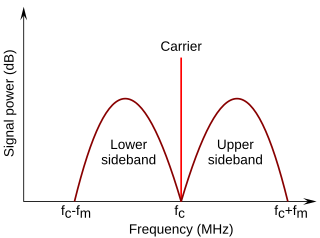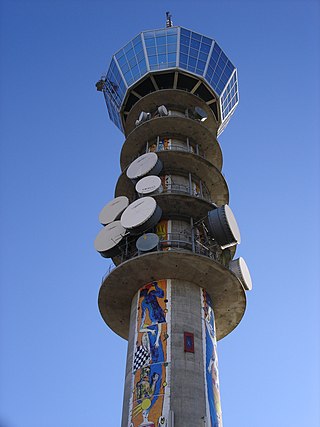Related Research Articles

Frequency modulation (FM) is the encoding of information in a carrier wave by varying the instantaneous frequency of the wave. The technology is used in telecommunications, radio broadcasting, signal processing, and computing.

A superheterodyne receiver, often shortened to superhet, is a type of radio receiver that uses frequency mixing to convert a received signal to a fixed intermediate frequency (IF) which can be more conveniently processed than the original carrier frequency. It was invented by French radio engineer and radio manufacturer Lucien Lévy. Virtually all modern radio receivers use the superheterodyne principle.

In radio communications, a sideband is a band of frequencies higher than or lower than the carrier frequency, that are the result of the modulation process. The sidebands carry the information transmitted by the radio signal. The sidebands comprise all the spectral components of the modulated signal except the carrier. The signal components above the carrier frequency constitute the upper sideband (USB), and those below the carrier frequency constitute the lower sideband (LSB). All forms of modulation produce sidebands.

In telecommunications, frequency-division multiplexing (FDM) is a technique by which the total bandwidth available in a communication medium is divided into a series of non-overlapping frequency bands, each of which is used to carry a separate signal. This allows a single transmission medium such as a microwave radio link, cable or optical fiber to be shared by multiple independent signals. Another use is to carry separate serial bits or segments of a higher rate signal in parallel.

Radio broadcasting is the broadcasting of audio (sound), sometimes with related metadata, by radio waves to radio receivers belonging to a public audience. In terrestrial radio broadcasting the radio waves are broadcast by a land-based radio station, while in satellite radio the radio waves are broadcast by a satellite in Earth orbit. To receive the content the listener must have a broadcast radio receiver (radio). Stations are often affiliated with a radio network that provides content in a common radio format, either in broadcast syndication or simulcast, or both. Radio stations broadcast with several different types of modulation: AM radio stations transmit in AM, FM radio stations transmit in FM, which are older analog audio standards, while newer digital radio stations transmit in several digital audio standards: DAB, HD radio, DRM. Television broadcasting is a separate service that also uses radio frequencies to broadcast television (video) signals.
In-band on-channel (IBOC) is a hybrid method of transmitting digital radio and analog radio broadcast signals simultaneously on the same frequency. The name refers to the new digital signals being broadcast in the same AM or FM band (in-band), and associated with an existing radio channel (on-channel). By utilizing additional digital subcarriers or sidebands, digital information is "multiplexed" on existing signals, thus avoiding re-allocation of the broadcast bands.
A subcarrier is a sideband of a radio frequency carrier wave, which is modulated to send additional information. Examples include the provision of colour in a black and white television system or the provision of stereo in a monophonic radio broadcast. There is no physical difference between a carrier and a subcarrier; the "sub" implies that it has been derived from a carrier, which has been amplitude modulated by a steady signal and has a constant frequency relation to it.

The FM broadcast band is a range of radio frequencies used for FM broadcasting by radio stations. The range of frequencies used differs between different parts of the world. In Europe and Africa and in Australia and New Zealand, it spans from 87.5 to 108 megahertz (MHz) - also known as VHF Band II - while in the Americas it ranges from 88 to 108 MHz. The FM broadcast band in Japan uses 76 to 95 MHz, and in Brazil, 76 to 108 MHz. The International Radio and Television Organisation (OIRT) band in Eastern Europe is from 65.9 to 74.0 MHz, although these countries now primarily use the 87.5 to 108 MHz band, as in the case of Russia. Some other countries have already discontinued the OIRT band and have changed to the 87.5 to 108 MHz band.
C-QUAM is the method of AM stereo broadcasting used in Canada, the United States and most other countries. It was invented in 1977 by Norman Parker, Francis Hilbert, and Yoshio Sakaie, and published in an IEEE journal.

Digital Radio Mondiale is a set of digital audio broadcasting technologies designed to work over the bands currently used for analogue radio broadcasting including AM broadcasting—particularly shortwave—and FM broadcasting. DRM is more spectrally efficient than AM and FM, allowing more stations, at higher quality, into a given amount of bandwidth, using xHE-AAC audio coding format. Various other MPEG-4 codecs and Opus are also compatible, but the standard now specifies xHE-AAC.
Digital radio is the use of digital technology to transmit or receive across the radio spectrum. Digital transmission by radio waves includes digital broadcasting, and especially digital audio radio services.
The International Telecommunication Union uses an internationally agreed system for classifying radio frequency signals. Each type of radio emission is classified according to its bandwidth, method of modulation, nature of the modulating signal, and type of information transmitted on the carrier signal. It is based on characteristics of the signal, not on the transmitter used.
In telecommunications, a pilot signal is a signal, usually a single frequency, transmitted over a communications system for supervisory, control, equalization, continuity, synchronization, or reference purposes.

FM broadcasting is a method of radio broadcasting that uses frequency modulation (FM) of the radio broadcast carrier wave. Invented in 1933 by American engineer Edwin Armstrong, wide-band FM is used worldwide to transmit high-fidelity sound over broadcast radio. FM broadcasting offers higher fidelity—more accurate reproduction of the original program sound—than other broadcasting techniques, such as AM broadcasting. It is also less susceptible to common forms of interference, having less static and popping sounds than are often heard on AM. Therefore, FM is used for most broadcasts of music and general audio. FM radio stations use the very high frequency range of radio frequencies.
Spectral efficiency, spectrum efficiency or bandwidth efficiency refers to the information rate that can be transmitted over a given bandwidth in a specific communication system. It is a measure of how efficiently a limited frequency spectrum is utilized by the physical layer protocol, and sometimes by the medium access control.
Shortwave bands are frequency allocations for use within the shortwave radio spectrum. Radio waves in these frequency ranges can be used for very long distance (transcontinental) communication because they can reflect off layers of charged particles in the ionosphere and return to Earth beyond the horizon, a mechanism called skywave or “skip” propagation. They are allocated by the ITU for radio services such as maritime communications, international shortwave broadcasting and worldwide amateur radio. The bands are conventionally named by their wavelength in metres, for example the ‘20 meter band’. Radio propagation and possible communication distances vary depending on the time of day, the season and the level of solar activity.
Apex radio stations was the name commonly given to a short-lived group of United States broadcasting stations, which were used to evaluate transmitting on frequencies that were much higher than the ones used by standard amplitude modulation (AM) and shortwave stations. Their name came from the tall height of their transmitter antennas, which were needed because coverage was primarily limited to local line-of-sight distances. These stations were assigned to what at the time were described as "ultra-high shortwave" frequencies, between roughly 25 and 44 MHz. They employed amplitude modulation (AM) transmissions, although in most cases using a wider bandwidth than standard broadcast band AM stations, in order to provide high fidelity sound with less static and distortion.

CCIR System B was the 625-line VHF analog broadcast television system which at its peak was adopted by more than one hundred countries, either with PAL or SECAM colour. It is usually associated with CCIR System G for UHF broadcasts.
CCIR System A was the 405-line analog broadcast television system adopted in the UK and Ireland. System A service started in 1936 and was discontinued in 1985.

CCIR System I is an analogue broadcast television system. It was first used in the Republic of Ireland starting in December 1961 as the 625-line broadcasting standard to be used on VHF Band I and Band III, sharing Band III with 405-line System A signals radiated in the north and east of the country. The Republic of Ireland has (slowly) extended its use of System I onto the UHF bands.
References
- ↑ "Spectral Emission Mask". Emerson.